In the previous installment in this series on Belizean dugout canoes, we looked at what appeared to be the most common form of propulsion -- the paddle. Here we'll look at other methods.
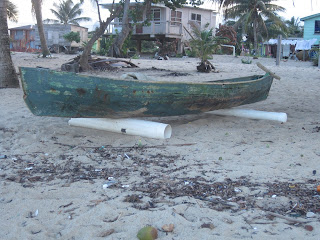 |
| Belizean sailing dugout canoe. The double-ended hull shows a sharp transition between the sternpost and the bottom, almost forming a skeg. The unshipped rudder sits in the stern sheets; its steering yoke is visible. (Click any image to enlarge.) |
Although we saw a couple canoes equipped for sail, we saw none that were rigged and ready to go, so the images provide unfortunately spotty documentation.
In discussions with canoe builders Leo and Francis Lewis, we learned that the typical rig uses a triangular jib and triangular (i.e., Marconi) main. On examining photos of canoes with mast steps, we see no evidence of a forestay on any of them, so we're not certain that a jib is actually in use. However, almost all of the canoes we saw had a small foredeck with a hole bored in it for a painter, which was sometimes present, sometimes not. There is a possibility that the painter might serve as a forestay when needed. If the jib is set flying, then its tack might conceivably to tied to the painter, but this seems even less likely.
 |
| The same boat shown above, displaying its stowed sailing rig. There are four poles, one of which must be the mast and one the boom. A third might conceivably be a kind of removable bowsprit to which the jib's tack is made fast. The fourth could be for poling, for ramming into the bottom to anchor the boat while fishing in shallows, or it might be a gaff or a sprit. The sail is nylon sailcloth, probably cut down and repurposed from the discarded sail of a cruising sailboat. Note also the auxiliary paddle stowed forward. |
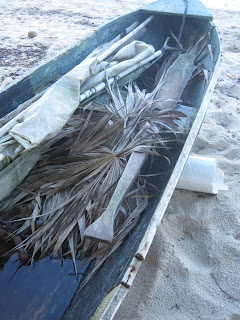 |
| The same boat, with a closer look at the spars, sail and paddle (the latter of which appears to be a cross between the two paddle types shown in the previous post). There are no chainplates or other provision for securing the lower ends of shrouds: the "mast partners" formed by the forward thwart (see below) evidently serve as the mast's only lateral support. |
 |
| The stern of the same boat, showing one horn of the rudder yoke (upper left), which is steered with lines leading forward. The pintles are simply bent straps of light galvanized steel nailed into the sternpost and hood ends of the planks. They do not look very durable, and probably allow the pintles to move around quite a bit. |
 |
| A different canoe from the one above, showing the mast step and forward thwart with a hole for the mast. |
Many of the canoes we saw had a mast steps and a mast hole in the forward thwart but no pintles or other evidence of sailing gear. If they are sailed, they are probably steered with a paddle. Another possibility is that some canoes are equipped with mast step but are never further equipped for sailing and never so used.
None of the sailing dugouts we saw had any kind of lateral plane: no keel or false keel, no centerboard well or evidence of leeboards. Leo Lewis told us that these were not necessary for sailing even on a beam reach, and that the boats were sailed for fishing alongshore or out to the cays and reefs. With their generally rounded bottoms, leeway must be significant.
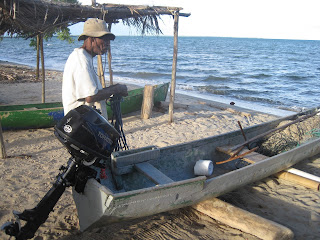 |
| Several of the dugouts we saw in Hopkins had transom sterns to hold small outboard engines. Tohatsu was the brand of choice. |
 |
| The fisherman's gear includes (from stern working forward): a bleach-bottle bailer; a crude, home-made stock anchor; a long, slender pole; nets; and floats. In the bow is an unidentified device that appears to have several long tines made of rebar. |
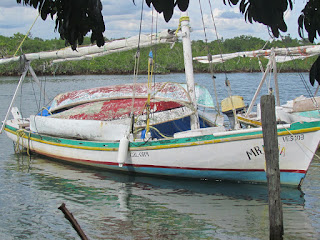 |
| In the town of Independence, we saw this sloop-rigged smack loaded with five dugout canoes on deck. The larger boat will carry the smaller ones out to fishing grounds, where they will be dropped over the side to fish. |
 |
| Another view of the smack's load of dugout canoes. |
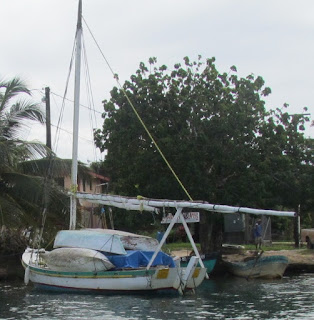 |
| Still another view, giving a more complete view of the smack's rig. It appears to have a short gaff, which has sagged below the very long boom. A third, dark-colored spar of unknown use (a whisker pole? a prop for the gaff's end?) is also visible just above the boom. |
* * *
This concludes the series on Belizean dugout canoes. Previous posts in the series are:











No comments:
Post a Comment